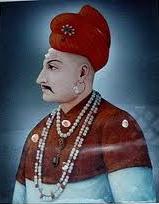
Baji Rao I, born as Visaji, also known as Bajirao Ballal, was the 7th Peshwa of the Maratha Empire. During his 20-year career as a Peshwa, he defeated Mughals and their vassal Nizam-ul-Mulk at several battles like the Battle of Delhi and Battle of Bhopal. Baji Rao's achievements are establishing Maratha supremacy in southern India and political hegemony in northern India. Thus, he was responsible for establishing Maratha power in Gujarat, Malwa, Rajputana and Bundelkhand all the way up to Bengal;and liberating Konkan from the Siddis of Janjira and Portuguese rule.

The Maratha Empire, later knows an the Maratha Confederacy was a confederacy that came to dominate a large portion of early modern India in the 18th century. Maratha rule formally began in 1674 with the coronation of Shivaji as the Chhatrapati. Maratha rule officially ended in 1818 with the defeat of last Peshwa named Bajirao II at the hands of the English East India Company. The Marathas are responsible for the end of the Mughal Empire over most of the Indian subcontinent.

The Peshwa was the appointed Prime Minister of the Maratha Empire of the Indian subcontinent. Originally, the Peshwas served as subordinates to the Chhatrapati ; later, under the Bhat family, they became the de facto leaders of the Maratha Confederacy with the Chhatrapati becoming a nominal ruler. During the last years of the Maratha Empire, the Peshwas themselves were reduced to titular leaders, and remained under the authority of the Maratha nobles and the British East India Company.

Balajirao Bhat, also known as Nana Saheb, was the 8th Peshwa of the Maratha Empire in India. He was appointed as Peshwa in 1740 upon the death of his illustrious father, the Peshwa Bajirao I.
Chhatrapati is a royal title from the Indian subcontinent. The word ‘Chhatrapati’ is a Sanskrit language compound word of chhatra and pati (master/lord/ruler). Chhatrapati means King of kings/Emperor .This title was used by the House of Bhonsle. It is considered to be the equivalent of an emperor, a sovereign and a symbolic representation of the protector of people.

Shahu Bhosale I was the fifth Chhatrapati of the Maratha Empire founded by his grandfather, Shivaji. Born in the Bhonsle family, he was the son of Sambhaji, Shivaji's eldest son and successor. He was captured at a very young age and held captive of the Mughals till the death of Mughal emperor, Aurangzeb. At that time he was released from captivity in the hope of keeping the Marathas locked in an internecine struggle.

Balaji Vishwanath Bhat (1662–1720) was the first of a series of hereditary Peshwas hailing from the Bhat family who gained effective control of the Maratha Empire during the 18th century. Balaji Vishwanath assisted a young Maratha Emperor Shahu to consolidate his grip on a kingdom that had been racked by civil war and persistently intruded on by the Mughals under Aurangzeb. He was called the Second Founder of the Maratha State. Later, his son Bajirao I became the Peshwa.

Rajaram Bhosle I was the third Chhatrapati of Maratha Empire, who ruled from 1689 to his death in 1700. He was the second son of the Shivaji, the founder of the empire and younger half-brother of Sambhaji, who he succeeded. His eleven-year reign was marked with a constant struggle against the Mughals. He was succeeded by his infant son Shivaji II under the regentship of his widow Tarabai.
The Battle of Palkhed was fought on February 28, 1728 at the village of Palkhed, near the city of Nashik, Maharashtra, India between the Maratha Empire and the Nizam-ul-Mulk, Asaf Jah I of Hyderabad wherein, the Marathas defeated the Nizam.

Tarabai Bhosale was the regent of the Maratha Empire of India from 1700 until 1708. She was the queen of Rajaram Bhonsale, and daughter-in-law of the empire's founder Shivaji. She is acclaimed for her role in keeping alive the resistance against Mughal occupation of Maratha territories after the death of her husband, and acting as the regent during the minority of her son

Ramchandra Neelkanth Bawadekar (1650–1716), also known as Ramchandra Pant Amatya, served on the Council of 8 as the Finance Minister (Amatya) to Emperor (Chhatrapati) Shivaji, dating from 1674 to 1680. He then served as the Imperial Regent to four later emperors, namely Sambhaji, Rajaram, Shivaji II and Sambhaji II. He authored the Adnyapatra, a famous code of civil and military administration, and is renowned as one of the greatest civil administrators, diplomats and military strategists of the Maratha Empire.
Khanderao Ballal , popularly known as ‘Khando Ballal’, was a diplomat in Maharashtra during the late 17th century and the early 18th century. He was also the Personal Assistant of Rajaram and Shahu. He is remembered for his support of Rajaram as he despised Sambhaji as he had executed his father "Ballal Avaji Chitnis".
Dhanaji Jadhav (1650–1708) was a warrior of the Maratha Empire. Along with Santaji Ghorpade he made terrifying campaigns against Mughal Army from 1689 to 1696. After Santaji, Dhanaji became the chief of the Maratha army in 1696 and remained on the post until his death in 1708.

Shankaraji Narayan Gandekar (1665–1707), also known as Shankaraji Narayan Sacheev or Shankaraji Narayan, was a popular Minister (Pradhan) and Count (Sardar) of the Maratha Empire. He also served as Imperial Secretary (Sacheev) during Emperor Chhatrapati Rajaram's reign. He also served as Deputy to the Crown (Rajadnya) under Emperor Sambhaji. His contribution to the war of independence against Mughal rule is considered to be immensely supportive. He was also the founder of the princely state of Bhor located, in Pune district.

Vijaydurg, the oldest fort on the Sindhudurg coast, was constructed during the regime of Raja Bhoja II of the Shilahar dynasty and restructured by Shivaji.
Umabai Dabhade was a prominent member of the Maratha Dabhade clan. The members of her family held the hereditary title senapati (commander-in-chief), and controlled several territories in Gujarat. After the deaths of her husband Khande Rao and her son Trimbak Rao, she exercised executive powers while her minor son Yashwant Rao remained the titular senapati. Her unsuccessful rebellion against Peshwa Balaji Baji Rao resulted in the downfall of the Dabhade family.

The following list includes a brief about the titles of nobility or orders of chivalry used by the Marathas of India and by the Marathis/Konkanis in general.
The Bhat Peshwa family earlier known as Bhat family is a prominent Indian Chitpavan Brahmin family who dominated India for around 100 years in the late 18th century and early 19th century. Most of the members in this family were the Peshwas in the Peshwa Era of the Maratha Empire, and Peshwa later became their family name. During their regime, most of the Indian subcontinent was under their control. The last Peshwa, Baji Rao II, was defeated by the British East India Company in the Third Anglo-Maratha War in 1818. The territory was annexed to the British East India Company's Bombay Presidency, and he was pensioned
Damaji Thorat was a chief of Maratha Empire. He had support from Ramchandra Pant. Rajaram I sent Thorat, Pawar and Athavle to make their established collections the chauth and sardeshmukhi, as they were termed, from the Mughal territory, and under the encouragement of success his officers added a third contribution for themselves under the head of ghasdana or forage money. In this manner a new army was raised whose leaders were Thorat, Pawar and Athavale. Rajaram I gave them honorary presents and rewards; the title of Vishwasrao was conferred on Pawar, of Rustumrao on Thorat and of Shamsher Bahadur on Athavle.












